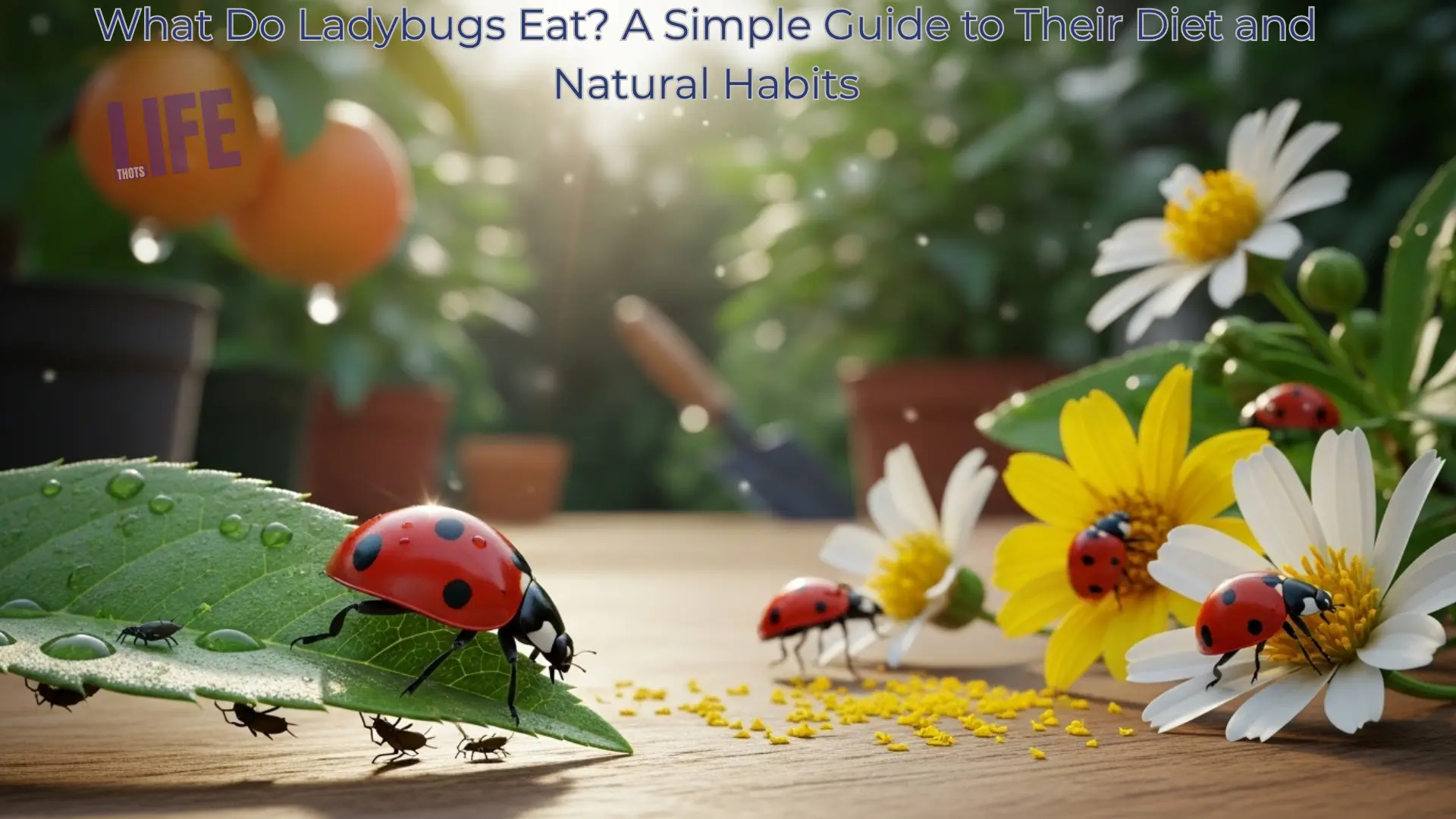Blog
What Do Ladybugs Eat? A Simple Guide To Their Diet and Natural Habits

What Do Ladybugs Eat? The Basics
When we talk about ladybugs, we often picture them devouring aphids. That’s accurate but only partly. Most ladybugs are carnivorous, feeding on soft-bodied insects that harm plants. Yet, depending on species, habitat, and season, their diet can shift to include other surprising foods.
The Tiny Garden Guardian
Have you ever wondered what our little red-and-black friends like to munch on? It turns out, their diet is far more diverse than you might think. Ladybugs, also known as ladybird beetles, aren’t just adorable they’re hardworking heroes of the garden. Their eating habits play a crucial role in keeping ecosystems balanced.
By preying on pests like aphids, whiteflies, and mites, ladybugs act as natural pest controllers, reducing the need for chemical pesticides in both gardens and farms. But that’s not the full story. These beetles also snack on nectar, pollen, and sometimes even plant tissue when food is scarce. So, what do ladybugs really eat? Let’s take a closer look at their surprisingly varied menu and see how it keeps the natural world thriving.
Aphids ;The Main Course
Aphids are the ladybug’s favorite meal. A single adult ladybug can consume up to 5,000 aphids in its lifetime that’s a lot of pest control packed into a tiny shell (source: Little Passports, 2024). These soft-bodied insects suck sap from plants, causing leaves to curl and crops to weaken. Ladybugs protect plants by hunting aphids with remarkable efficiency, often patrolling leaves and stems to catch them in clusters.
Other Small Insects
When aphids are scarce, ladybugs happily switch targets. Their menu includes:
- Whiteflies – common on indoor plants and greenhouse crops.
- Mites – tiny pests found on vegetable leaves and fruit trees.
- Mealybugs and scale insects – destructive sap-feeders that ladybugs readily attack.
By eating these pests, ladybugs safeguard entire ecosystems from backyard gardens to large agricultural fields.
Beyond Insects: Surprising Foods Ladybugs Enjoy
Even though most ladybugs are natural-born hunters, some species have expanded their diets to survive in changing environments. Let’s explore some lesser-known items on their menu.
Leaves
Some ladybugs occasionally nibble on leaves, especially when prey is scarce. Though leaves don’t provide much protein, they offer moisture and a temporary food source. The Twenty-Eight-Spotted Ladybug (Epilachna vigintioctopunctata), found in Asia and Africa, is a prime example it’s a herbivorous species that feeds on leaves of solanaceous plants like potatoes and tomatoes (source: Journal of Insect Science, 2023).
Seeds
Seeds are packed with proteins and fats that sustain ladybugs when other food runs out. Research on the Multicolored Asian Ladybug (Harmonia axyridis) shows they sometimes consume seeds during late summer when insect prey declines (source: Entomological Research Society, 2024).
Fungus
Ladybugs such as the Seven-Spotted Ladybug (Coccinella septempunctata) and the Sordid Ladybug have been observed feeding on fungal matter. Fungi offer vitamins, amino acids, and fatty acids a nutritious fallback during damp seasons when mushrooms thrive. This habit helps ladybugs survive in shaded, forested environments.
Nectar
Nectar is not just for bees. Many adult ladybugs sip nectar to maintain their energy, especially when hunting. The Seven-Spotted Ladybug, native to Europe, frequently visits wildflowers for nectar, while the Multicolored Asian Ladybug in North America enjoys flower-rich meadows. Nectar’s natural sugars keep them active and improve reproductive success (source: Crop Watch, University of Nebraska, 2024).
Pollen
Ladybugs don’t just spread pollen they eat it too. Pollen is rich in proteins, fats, and minerals. In particular, Harmonia axyridis and Epilachna varivestis consume pollen from wildflowers and corn plants, supporting their fertility and longevity.
Plants
While most ladybugs help plants, a few species are plant-eaters. The Mexican Bean Beetle (Epilachna paeninsularis) feeds on the leaves of beans and legumes across Central and North America. Although they belong to the ladybug family, their vegetarian lifestyle sometimes makes them pests instead of protectors (source: Britannica, 2024).
Fruit
Ladybugs sometimes enjoy overripe fruit, especially when seeking sugar. The Pink-Spotted Ladybug, common in North America, has been observed feeding on decaying fruit surfaces. The natural sugars provide a quick burst of energy, helping them stay active even when insects are unavailable.
Vegetables
In agricultural settings, species like Epilachna varivestis (southern corn rootworm ladybug) feed on corn leaves and legume crops. These exceptions remind us that while most ladybugs are beneficial, a few have developed a taste for greens.
Sugar
Sugary juices from fruits or honeydew (a sticky substance left by aphids) are another vital source of energy. Studies show that these sugars improve ladybug stamina and reproduction rates, especially in cooler climates (CropWatch, 2024).
Eggs
Yes ladybugs sometimes eat insect eggs, including those of other species. This isn’t as sinister as it sounds; it’s nature’s way of recycling nutrients. The Seven-Spotted Ladybug and the Southern Corn Rootworm Ladybug have been seen consuming insect eggs for protein during breeding seasons.
How Much Do Ladybugs Eat?
Ladybugs are tiny but their appetites are huge. On average, an adult can consume 40–50 aphids per day. Over its lifespan, that’s roughly 5,000 aphids (source: Little Passports, 2024).
Their hunting behavior is efficient: they detect prey through chemical cues released by plants under attack, then patrol leaves, devouring pests as they go. Because of this, many farmers use ladybugs as a biological pest control method, reducing the need for harmful pesticides.
In short, ladybugs are small but mighty saving crops, gardens, and even your houseplants one meal at a time.
The Role of Ladybug Diet in Ecosystems
What ladybugs eat directly affects the health of their habitats. By controlling pest populations, they:
- Maintain ecological balance in gardens and forests.
- Prevent pest outbreaks that could destroy crops.
- Reduce dependence on synthetic pesticides making agriculture more sustainable.
When they switch to nectar and pollen, they also help pollination, contributing to plant diversity. This dual role as predator and pollinator makes ladybugs one of the most beneficial insects on Earth.
FAQs
Q1. What do ladybugs eat in winter?
In winter, ladybugs hibernate in groups under leaves, bark, or rocks. Their feeding slows drastically. Some may sip honeydew or nectar if available, but most rely on stored fat reserves.
Q2. Do all ladybugs eat aphids?
No. Most do, but herbivorous species like the Mexican Bean Beetle feed on plants instead. Always identify the species before assuming it’s beneficial.
Q3. Can I feed ladybugs sugar water indoors?
Yes mix a few drops of honey with water on a cotton ball. It keeps captive ladybugs hydrated and energized until release.
Q4. Why did ladybugs disappear from my garden?
If aphids or pests are gone, ladybugs may move elsewhere in search of food. Plant nectar-rich flowers like dill or calendula to encourage them to stay.
Q5. Are ladybugs harmful to humans or pets?
Not at all. They don’t bite, sting, or carry disease. The only “harm” they can do is leave a mild yellowish scent when handled roughly.
Final Thoughts
So, what do ladybugs eat? A bit of everything from aphids to nectar, from fungi to fruit. But more than their diet, it’s their ecological impact that makes them special. They’re the silent workers keeping your garden balanced and vibrant. The next time you spot one on a rose leaf or tomato stem, remember: that tiny beetle is your best unpaid gardener, doing the hard work of protecting your plants one bite at a time.
